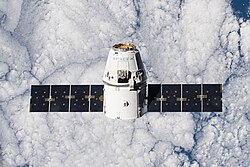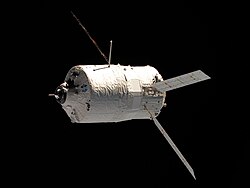Cygnus CRS OA-9E
| S.S. J.R. Thompson[1] | |||
 | |||
| Beställare | NASA | ||
|---|---|---|---|
| Uppkallad efter | J.R. Thompson | ||
| Tillverkare | Orbital ATK Thales Alenia Space | ||
| Modell | Cygnus förstärkt | ||
| Operatör | Orbital ATK | ||
| NSSDC-ID | 2018-046A[2] | ||
| Uppskjutning | |||
| Startplats | MARS LP-0A, Wallops Flight Facility | ||
| Raket | Antares 230 | ||
| Uppskjutning | 21 maj 2018, 08:44:06 UTC[3] | ||
| Återinträde | |||
| Återinträde | 30 juli 2018, 09:17 UTC | ||
| Omloppsbana | |||
| Banlutning | 51,6° | ||
| Dockning | |||
| Rymdstation | ISS | ||
| Greppad | 24 maj 2018, 09:26 UTC | ||
| Dockning | 24 maj 2018, 12:13 UTC | ||
| Dockningsport | Unity, nadir | ||
| Ur dockning | 15 juli 2018, 10:20 UTC | ||
| Släppt | 15 juli 2018, 12:37 UTC | ||
| Tid dockad | 52 dagar, 54 minuter | ||
| Kronologi | |||
| |||
Cygnus CRS OA-9E även känd som Orbital Sciences CRS Flight 9E, var en flygning av en av företaget Orbital ATKs Cygnus rymdfarkoster till Internationella rymdstationen (ISS). Farkosten sköts upp med en Antares 230 raket från Wallops Flight Facility i Virginia den 21 maj 2018[3].
Farkosten är uppkallad efter den avlidne amerikanen J.R. Thompson[1]. Målet med flygningen var att leverera material och förnödenheter till ISS. Farkosten dockades med rymdstationen med hjälp av Canadarm2 den 24 maj 2018 och lämnade stationen den 15 juli 2018. Den brann som planerat upp i jordens atmosfär den 30 juli 2018.
Källor
Fotnoter
- ^ [a b] ”Orbital ATK” (på engelska). Orbital ATK. Arkiverad från originalet den 14 maj 2018. https://web.archive.org/web/20180514141618/https://www.orbitalatk.com/news-room/feature-stories/OA9-Mission-Page/Documents/SS_JR%20Thompson_Bio.pdf. Läst 11 november 2017.
- ^ ”NASA Space Science Data Coordinated Archive” (på engelska). NASA. https://nssdc.gsfc.nasa.gov/nmc/spacecraft/display.action?id=2018-046A. Läst 24 mars 2020.
- ^ [a b] ”Orbital ATK” (på engelska). Orbital ATK. Arkiverad från originalet den 22 maj 2018. https://web.archive.org/web/20180522041255/https://www.orbitalatk.com/news-room/feature-stories/oa9-mission-page/. Läst 12 november 2017.
| ||||||||||||||||||||||
| ||||||||||||||||||||||||||||||||
Media som används på denna webbplats
A Progress supply ship linked up to the orbiting International Space Station (ISS) at 3:48 GMT, November 18, bringing Expedition 1 commander William M. Shepherd, pilot Yuri P.
Gidzenko and flight engineer Sergei K. Krikalev two tons of food, clothing, hardware and holiday gifts from their families. The photograph was taken with a 35mm camera and the film was later handed over to the STS-97 crew members
for return to Earth and subsequent processing.Backdropped by a cloud-covered part of Earth, the Orbital Sciences' Cygnus cargo craft approaches the International Space Station, photographed by an Expedition 40 crew member. The two spacecraft converged at 6:36 a.m. (EDT) on July 16, 2014.
ISS021-E-017623 (30 Oct. 2009) --- Backdropped by a cloud-covered part of Earth, the unpiloted Japanese H-II Transfer Vehicle (HTV), filled with trash and unneeded items, departs from the International Space Station. European Space Agency astronaut Frank De Winne, Expedition 21 commander; NASA astronaut Nicole Stott and Canadian Space Agency astronaut Robert Thirsk, both flight engineers, used the station's Canadarm2 robotic arm to grab the HTV cargo craft and unberth it from the Harmony node's nadir port. The HTV was successfully unberthed at 10:18 a.m. (CDT) on Oct. 30, 2009, and released from the station's Canadarm2 at 12:32 p.m.
This image, photographed by one of the Expedition 42 crew members aboard the International Space Station, shows the SpaceX Dragon cargo craft approaching on Jan. 12 2015 for its grapple and berthing and the start of a month attached to the complex. Dragon carried more than 2 ½ tons of supplies and experiments to the station.
ISS026-E-037172 (24 Feb. 2011) --- Surrounded by the blackness of space, the European Space Agency's "Johannes Kepler" Automated Transfer Vehicle-2 (ATV-2) approaches the International Space Station. Docking of the two spacecraft occurred at 10:59 a.m. (EST) on Feb. 24, 2011.
NASA insignia for Orbital ATK's OA-9E resupply flight
The Expedition 37 crew captured Cygnus with the Canadarm2 at 7 a.m. EDT Sunday, Sept. 29, 2013, and attached it to the Harmony node at 8:44 a.m.










